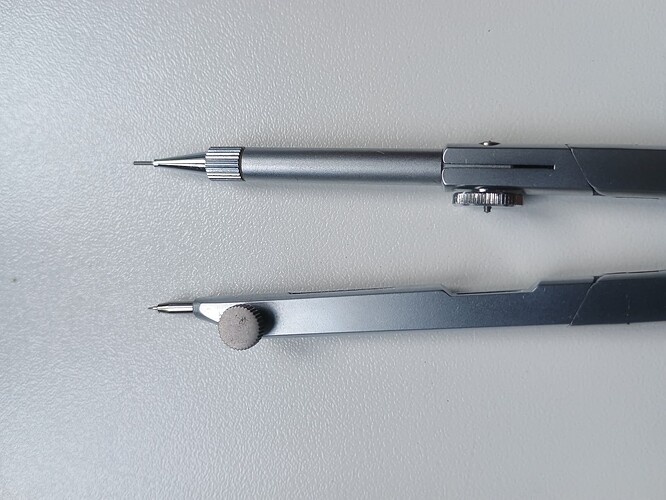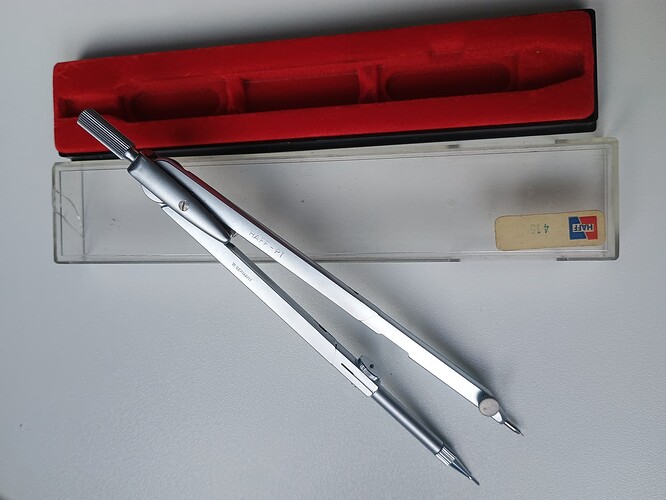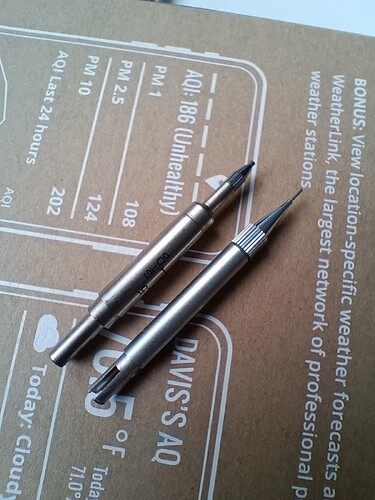In this friendly but fierce game of ours, where we are all interested in the same, super-niche sector, and we all crave for information and lucky strikes, the sub-sub-category of items we probably chase the most is that of the unicorns: impossible-to-find and highly-sought-after mechanical pencils, lead holders, or just random accessories, sometimes available at astronomical prices, that we all would like to get for next-to-nothing, in the ultimate win against the dreadful Fate, against ourselves, or just against the other bidders.
While I have put my fair share of energy, money, and time to get some unicorns, I can’t but prefer yet another sub-sub-set of the world we all cherish here; in the absence of any better term to describe what I mean, and right before the formal definition I am about to give, I shall simply call this category: ghosts.
Ghosts and unicorns have something in common: they are all very, very rare. Not necessarily precious, or special in any other sense, nor expensive in any case, but rare to say the least. The main difference however, what drives the two classes apart, is that for unicorns, we have at least some sort of previous knowledge (one reference inside a known catalogue; a badly-taken picture from someone’s old collection which keeps cropping up; one mention in an auction site citing product name and code, and a starting price).
Ghosts “are not really in the world”, until someone gets to unveil one: no product codes around, no pictures from previous owners, no sources confirming or denying their very existence. For all practical purposes, the community does not know they are around (because they are not, usually), and therefore is not actively looking for them.
So, regarding ghosts, only a happy, first-hand encounter — and, hopefully, acquisition — confirms their existence once and for all. This event, if not publicly advertised, remains a private moment in one collector’s life: the ghost is not a ghost anymore, but just for one more person in the whole world; all the other people around, unaware of its silent presence, keep on wandering without wanting something they know nothing about.
This is the element I probably find more interesting in the whole topic of ghosts and their impossible hunt. And this is my ghost story.
Let us jump back in time to, say, October 2023: I am visiting the nice city of Vicenza, right in the most productive area in Italy (the Northern-Eastern part), to attend a crafting and knitting fair with the lady who’s going to be my wife. I love weird tools, so I am happy to chaperon her to Vicenza and buy tiny tweezers, special pliers, and unusual stamps, while Ms. Leonov swims in a sea of threads, bobbins, textile samples, and empowered women liberating their inner creativity.
The pact is, however, that one fraction of our two-days trip will be spent visiting stationery stores, and looking for “my stuff”. So, one rainy afternoon, I am running between the three main shops I had previously selected — I try to come prepared to such hunting spots — and it is of course a parade of old drawers opened, drafting tools dusted off, vintage stuff acquired, and money leaving my wallet. Above all, I gather stories from very old shop owners who at once lament the poor state of their trade, and praise the excellence they were used to in the good old days. Turns out the technical schools in Vicenza trained some of the most specialised engineers between 1940 and 1960, some of which helped building or maintaining the Panama canal, and the city thrived in the subtle art of technical drawing.
At one place I meet a grumpy guy with sharp manners, and a general disdain for time wasted; the dialogue is tense at times, but I manage to buy some broken or damaged items for a cheap figure (including a F.C. TK-Matic I’ll repair that same night), and I show him I can be as knowledgeable a person as some of his more frequent customers. It gets late, the guy softens enough to let his personal pride emerge, and offers to show me his own collection of drafting instruments. I will not be able to buy anything, but the offer is definitely intriguing, so I happily accept.
The shop owner has indeed many great pieces, from the golden-age manufacturers (Clemens Riefler, Kern, rOtring, Werein Aristea, O. Richter, &c.) but he does not know how many contraptions and rare oddities I have accumulated over the years, so his almost snarky remarks ricochet. At one point, however, he drags one item out of his last drawer, and there I am, flabbergasted. What I am witnessing is something I have never seen in a catalogue, nor I thought could exist outside Japan, nor should exist at all. Instead it is there, right in front of my eyes.
The item is a pair of compasses from the Gebruder Haff company, based in Pfronten, and making drafting tools with the highest level of precision and accuracy; their stuff is often rebranded — for rOtring, they produce a particularly clever quick adjustment but high-grade compass, with a quarter-of-circle dented extension working in conjunction with a threaded knob to set the radius of the circle — but their style is almost unmistakable.
Haff offers not one, not two, not three, but four different lineups, from the “U” series (“Universell”, for general purposes and high-schoolers), to the “PT” series (“Präzision-Techniker”, for professionals), to the famed “PS” series (“Präzision-Spezial”, for the most prestigious and hair-splitting clients), each one with a complete sub-catalogue of sets, tools, and complementing accessories; finally, there is the “Special instruments” series (“Sonderinstrumente”), which covers anything from compensating polar planimeters, to coordinatographs, to proportional compasses, to 10-points dividers.
As I said, my ghost is a pair of compasses from the “PT” series, the mid-range one, and it might look exactly like a regular instrument, were it not for the totally unexpected leg attachment I immediately notice.
It is a twistaction mechanical pencil insert for 0.5 thin-lead cores, made in the same finish and material of the rest of the body (copper alloy, polished and chromium plated). And it should not be there, as Haff has other MP inserts (“Bleieinsätze”) made in plastic and perfectly identical to the burgundy-coloured rOtring inserts discussed here.
The insert is most likely Japanese, possibly originally made by Uchida, but this is hard to say because, save for the striking resemblance to inserts typically available in their sets, there is absolutely zero evidence on all the catalogues I have of such an item. Uchida would produce some inserts for Haff, but the known ones are for their plastic Ellipsographs (no. 96 and 97E), and look larger, with the twisting, grooved band on the opposite end of the cylinder, rather than close to the writing tip.
The specimen owned by the shop manager does not come with any identification number: it is just there, it is real, I can see it, but I have no idea about how, why, when and where it came to be. It seems that the attachment was not an accessory of a larger set, but the original part this pair of compasses were designed to get out of the assembly line with.
I have just seen my ghost. Now I know. And I also know that I will never find another one.
Once back at home, I try gathering as much data as I can, but things do not seem to line up correctly. My only hints are: 1) that the identification number, if it ever existed, ought to begin with a “4”, as that is the starting cypher for all “PT”-related specimens, and; 2) that there should be at least one other element in their catalogue where this particular leg attachment may be listed as available (but without any dedicated number, or accompanying picture, so it might be the burgundy, plastick-y equivalent), and it is the unicorn known as the “Haff 95E Elliptical Trammel — System Linnhoff DBGM” (well, a variant of it, back when it was made in the same alloy the PT-series was produced: mine for instance comes in the “specially chromium plated” finish found in the “PS” lineup, so either it is a successor, or a predecessor of the contraption displayed in the 1971 main catalogue, or in the 1964 brochure).
The ghost visits me in my dreams, but in the meantime something similar makes it to my home, thanks to the one and only @Gunther , who super-generously sends a similar thin-lead compass insert — also made in Japan — but with a sort of “pushbutton” mechanism, like the ones found in more recent compass sets, and also available at some point by Staedtler Japan.
Over the months, I get more and more convinced that all that conversation in a shop in Vicenza was little more than a dream itself, and maybe the Haff specimen I thought i saw was a hallucination altogether; after all, I spotted so many things that day.
Fast forward to October 2024; a listing on Ebay appears — and I find it by chance, as I do not have any alert on for this sorts of stuff — for what seems a normal pair of compasses from the PT-lineup by Haff; a careful inspection of the pictures, however, shows an anomaly in the right leg. The compass has its own case, with an identification number reading “Haff PS-415”. Interesting; very interesting.
There is a strange fluctuation in the Force as I rush to buy the thing, and an even more tense feeling as I wait for the parcel to arrive (and by the way: the [old] seller cancels the transaction on Ebay because he finds out that the shipping rates are too high for his taste; fortunately, he is willing to sell the item on another platform, with reportedly more convenient fees).
When I open the package, the ghost is there. Almost NIB. The twistaction mechanism is stuck, but starts working fine after some elbow grease is applied. the transparent lid in the case has a crack, but it still holds together. I busted my first ghost. I will need to take pictures, and tell the story for the future generations.
By the way: now I can pair the insert with my elliptical trammel, or use the pair of compasses as it was originally intended. Needless to say, I am happy.
Happy holidays everybody! ![]()







